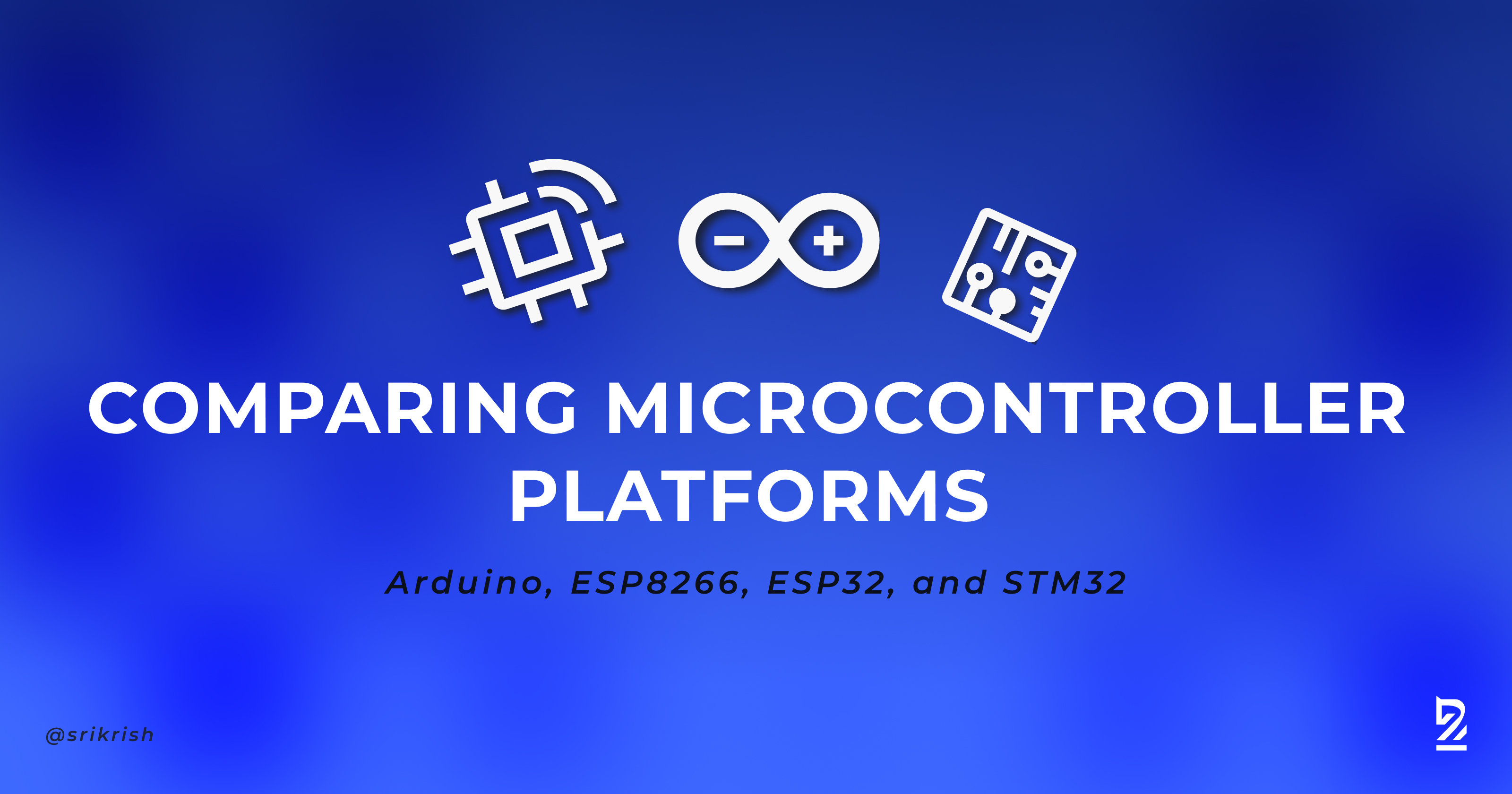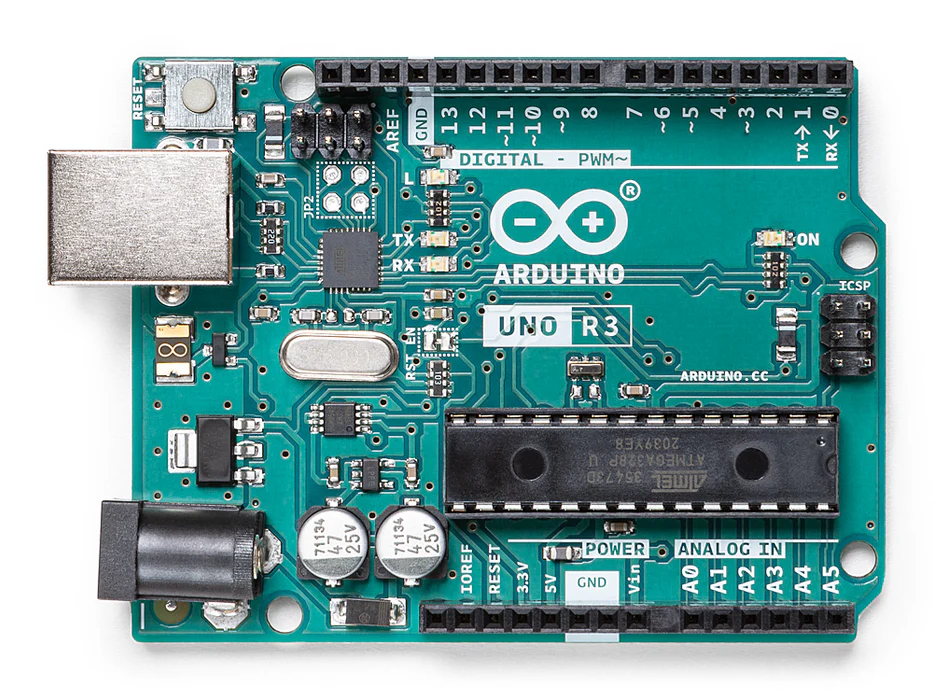Choosing the Right Microcontroller: A Comparison of Arduino, ESP8266, ESP32, and STM32f4 series
 Sri Krishna
Sri Krishna
Microcontroller platforms play a pivotal role in modern electronics, enabling developers to build everything from basic hobbyist projects to sophisticated IoT systems. In this blog, we will compare four popular microcontroller platforms—Arduino, ESP8266, ESP32, and STM32—in terms of architecture, features, use cases, and ecosystem support.
Arduino UNO
Arduino is a well-known open-source platform ideal for beginners and hobbyists. It includes both the hardware (various Arduino boards) and software (Arduino IDE), making it highly accessible.

Pros:
Ease of Use: Simple plug-and-play design with a beginner-friendly IDE.
Large Community: Extensive online resources, tutorials, and community support.
Wide Range of Shields: Modular approach with stackable shields for adding extra functionality (e.g., sensors, displays, motor drivers).
Cons:
Limited Processing Power: Slow clock speed and limited RAM compared to modern microcontrollers.
No Built-in Connectivity: Needs additional shields for Wi-Fi, Bluetooth, etc.
Best Suited For:
Beginners and educational projects.
Simple automation, control systems, and DIY projects.
NodeMcu(ESP8266)
ESP8266 is a low-cost Wi-Fi-enabled microcontroller platform. It’s highly popular for IoT applications due to its integrated Wi-Fi and ease of use.

Pros:
Cost-Effective: One of the most affordable microcontrollers with built-in Wi-Fi.
Small Form Factor: Ideal for compact projects.
IoT-Friendly: Easily integrates with cloud platforms like AWS, Google Cloud, and Blynk.
Cons:
Limited GPIOs: Fewer pins compared to other platforms, which can limit peripheral expansion.
Complex Power Management: Can be power-hungry, making battery-powered designs tricky without optimizations.
Best Suited For:
IoT applications like smart homes, connected devices, and sensor networks.
Projects requiring internet connectivity on a budget.
ESP32
ESP32 is the successor to ESP8266 and offers more processing power, dual-core support, and integrated wireless communication features like Wi-Fi and Bluetooth.

Pros:
Dual-Core Processor: Improved performance for multitasking and real-time applications.
Integrated Wi-Fi and Bluetooth: Suitable for a wide range of wireless communication projects.
Rich Peripheral Set: Supports multiple communication protocols and hardware interfaces.
Cons:
Higher Power Consumption: More power-hungry than Arduino and ESP8266, though deep sleep modes can mitigate this.
Overkill for Simple Projects: May be too complex and powerful for simple tasks where other microcontrollers could suffice.
Best Suited For:
Advanced IoT applications that require dual connectivity (Wi-Fi + Bluetooth).
Real-time projects like home automation, wearables, and multimedia streaming.
Complex projects needing more processing power and peripherals.
STM32f4 series
STM32 is a family of 32-bit ARM Cortex-M microcontrollers from STMicroelectronics. Known for its performance and power efficiency, it is widely used in industrial and embedded systems.

Pros:
High Performance: ARM Cortex architecture provides excellent performance for demanding applications.
Low Power Consumption: Advanced power management modes for energy-efficient designs.
Wide Range of Models: Available in a variety of configurations for different applications, from low-power to high-performance needs.
Cons:
Steep Learning Curve: Requires a deeper understanding of microcontroller architecture and embedded systems compared to Arduino.
Complex Development Environment: More challenging to set up and use than simpler platforms like Arduino.
Best Suited For:
Industrial and commercial applications.
High-performance embedded systems like automotive, medical devices, robotics, and aerospace.
Low-power designs requiring advanced power management.
Comparison Table for Arduino vs ESP8266 vs ESP32 vs STM32F4 Series
| Feature | Arduino (UNO) | ESP8266 | ESP32 | STM32F4 Series |
| Microcontroller | ATmega328P | Tensilica Xtensa L106 | Tensilica Xtensa LX6 (dual-core) | ARM Cortex-M4 (with FPU) |
| Architecture | 8-bit AVR | 32-bit | 32-bit | 32-bit ARM Cortex-M4 |
| Clock Speed | 16 MHz | 80 MHz (up to 160 MHz) | Up to 240 MHz | Up to 180 MHz |
| RAM | 2 KB | 64 KB instruction, 96 KB data | 520 KB SRAM | 128 KB to 384 KB |
| Flash Memory | 32 KB | 512 KB to 4 MB | 4 MB to 16 MB | 512 KB to 2 MB |
| Operating Voltage | 5V | 3.3V | 3.3V | 3.3V |
| I/O Pins | 14 digital, 6 analog | 11 digital, 1 analog | 34+ GPIO pins | Up to 100+ GPIO(differs for each board) |
| ADC/DAC | 10-bit ADC | 10-bit ADC | 12-bit ADC, 8-bit DAC | 12-bit ADC, 12-bit DAC |
| Connectivity | None (without shield) | Built-in Wi-Fi (802.11 b/g/n) | Built-in Wi-Fi + Bluetooth | Ethernet, USB, CAN |
| Power Consumption | Low | Medium | High (with low-power modes) | Very low with multiple power-saving modes |
| USB Interface | Yes (via onboard USB) | Yes(via micro USB) | Yes | Yes |
| Development Environment | Arduino IDE | Arduino IDE, ESP-IDF, PlatformIO | Arduino IDE, ESP-IDF, PlatformIO | STM32CubeIDE, Keil, IAR |
| Ease of Use | Beginner-friendly | Moderate complexity | Moderate complexity | Advanced (requires professional knowledge) |
| Best For | Simple DIY projects, education | Basic IoT applications | Advanced IoT, real-time tasks | Industrial, automotive, high-performance systems |
Selecting the right microcontroller depends on the complexity and requirements of your project. For beginners and educational projects, Arduino is the best choice due to its simplicity and community support. For IoT applications requiring Wi-Fi, ESP8266 and ESP32 are highly popular due to their cost-effectiveness and built-in wireless connectivity. STM32 stands out for industrial applications requiring robust performance, low power, and advanced peripherals.
Key Takeaways:
Arduino: Ideal for beginners and hobbyists.
ESP8266: Best for cost-effective IoT applications.
ESP32: Suitable for advanced IoT projects requiring both Wi-Fi and Bluetooth.
STM32: Best for industrial, high-performance embedded systems.
"In the world of microcontrollers, choosing the right platform is like selecting the perfect tool—each has its unique strengths, but success lies in understanding your project's needs and harnessing the power of innovation."
Subscribe to my newsletter
Read articles from Sri Krishna directly inside your inbox. Subscribe to the newsletter, and don't miss out.
Written by
